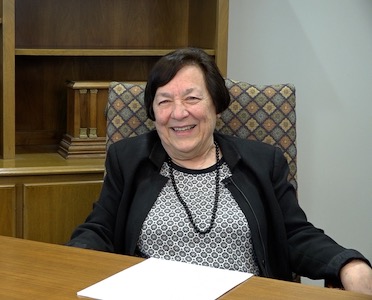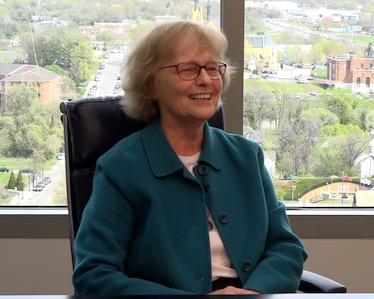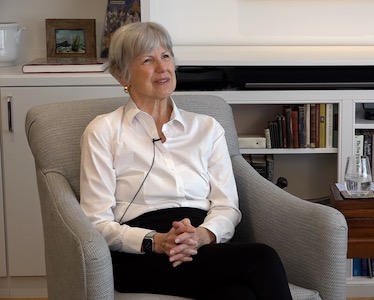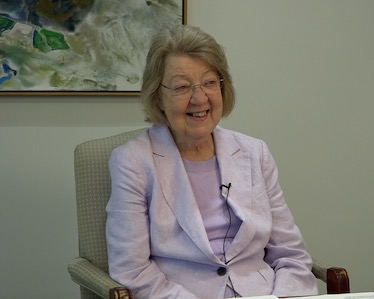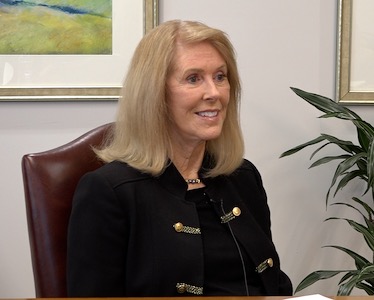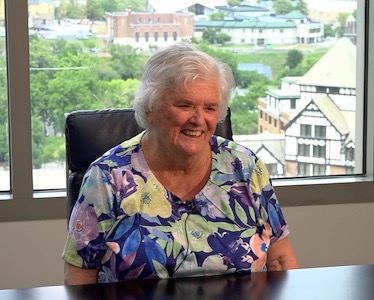Oral History Project
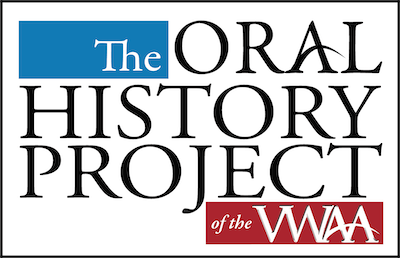
Recent Additions
About the Project
The Oral History Project was originated by the VWAA Roanoke Chapter to capture the stories and wisdom of the first female attorneys to practice in the Roanoke area of Virginia. These first videos and transcripts are the initial launch and the VWAA encourages all chapters to add their region’s history making women to this section. If you are interested in conducting your own interviews, contact Sharon Chickering for tips on how to get started.
Introduction
The first women attorneys to practice in Roanoke are generally now in their 70s, and the VWAA Roanoke Chapter realized that time was running out to record and preserve their groundbreaking contributions to the progress of women attorneys in Virginia and in particular in the 23rd Judicial Circuit, which encompasses Roanoke, Salem and Roanoke County. So, the chapter has undertaken this Oral History Project, recording the oral histories of these trailblazing first women attorneys to practice in the Roanoke Valley in the 1970’s. And, as you’ll read and see, what stories they have to tell!
Believe it or not, in 1970, there were no women attorneys practicing in the Roanoke Valley of Virginia, according to the membership handbook of the Roanoke Bar Association, an organization which was incorporated in 1925.1 By 1977, only eight women attorneys were listed in the RBA membership handbook as practicing in the Roanoke Valley: V. Anne Edenfield, Angelica D. Lloyd (now Light), Sarah H. Ludwig, Diana M. Perkinson, Melba C. Pirkey (deceased), Linda F. Steele (deceased), Diane M. Strickland (now a retired circuit court judge), and Patricia H. Quillen. By 1980, the number of women attorneys had grown to include Betty Jo Anthony, Tonita M. Foster (deceased), Joan M. Gardner, Maryellen Goodlatte, Carol B. Gravitt, Evelyn K. Krippendorf, Lea (Lynn) Lautenschlager, Barbara Mason, Jennifer Mulligan, Susan R. Robertson, and Parthenia E. Fields.2 In addition, Ellen S. Weinman, with an office in the City of Salem, was also practicing in the Roanoke Valley at this time, although she was not a member of the Roanoke Bar Association. Judge Strickland has the additional experience of being the only female to have been named to the 23rd Judicial Circuit Court bench in its history.
First Law Graduates
The dearth of women attorneys in Virginia prior to 1975 is not surprising. There were four law schools in Virginia at that time – William & Mary, the University of Virginia, the University of Richmond, and Washington & Lee. Although the Virginia General Assembly in 1918 authorized William & Mary to admit white women students, between 1937 and 1970, only 27 women graduated from its law school, and only 4% of the graduating law school class of 1973 were women. By 1976, that percentage increased to 17%, and by fall 1977 28% of the incoming law class of 1980 were women.3 According to the school website, the first Asian American woman was admitted to the undergraduate school in 1933, and the first Black woman was not admitted until 1967.4
Similarly, the University of Virginia graduated the first woman from its law school in 1923,5 but women law graduates were a rarity, and full and unrestricted co-education did not take place until 1972, after the university was sued in federal court for gender discrimination, forcing the Board of Visitors to vote to open the college to women and making it among the last institutions to go co-ed. Ironically for the Roanoke Chapter VWAA Oral History Project, the primary person responsible for the tenacity with which the school fought the discrimination law suit, according to a 2020 article in Virginia Magazine, was Frank W. Rogers, Sr., Rector of the Board of Visitors at the time, and founder of the Roanoke firm, Woods Rogers Muse & Walker.6 In that article, editor and author Richard Gard quotes Leigh B. Middleditch, the school’s in house legal advisor at the time of the suit, saying of Rogers, “He was a tough bird, and he did not want to be pushed around by anybody. He just put in his heels.” Gard reported that Rogers, a World War I fighter pilot and 1909 undergraduate and 1914 law graduate of the university, wrote to a disappointed alumnus after the Board’s vote, “I see nothing good in co-education at the University.” 7
The University of Richmond law school graduated its first woman in 1923, as well, Jane Brown Ranson, making her one of the first women to earn a law degree in Virginia. The university claims no reliable data that records enrollment at the law school by gender until 1992, but speculates enrollment of women did not significantly increase until 1980, using census data trends of the number of women attorneys practicing in the state. According to the school website, in the 1920 census, six women were practicing law in Virginia; by 1930, the number was 27; and by 1950, the number exceeded 100. It was not until the 1980 census that the number of women practicing law in Virginia numbered in the thousands.8
The initial admission of women to their law schools in the late 1900’s/early1920’s at the University of Virginia, William & Mary and the University of Richmond (then Richmond College) coincided with the passage by Congress of the 19th Amendment, granting women the right to vote, and was not without its critics at each of the schools. Indeed, the Commonwealth of Virginia voted against ratification of the 19th Amendment. Since 1895, the law in Virginia governing licensure of attorneys had applied specifically and only to “any male citizen”, and when Virginia finally admitted women to the bar in 1920, it was one of the last three states to do so, along with Rhode Island and Delaware.9
Washington & Lee, a private institution, did not admit women to their law school until 1972 in the face of losing its accreditation. And who was behind the law school accreditation scare? The Association of American Law Schools (AALS) and its Committee on Women in Legal Education, on which sat none other than Ruth Bader Ginsburg. As Ginsburg recounted it in an interview with AALS President Vicki Jackson in Washington, D.C. in January, 2020, the primary mission of the committee was to have every law school add the category “sex” to its non-discrimination policy already covering race, religion, and national origin: “There was, at the time, at the start of the 70’s one law school, Washington & Lee, that was still all-male. It was part of an all-male university. The faculty of Washington & Lee wanted very much to open admission to women, but they were part of this all-male institute. The faculty cheered our effort because it could then go to the university and say, ‘we’re going to be dropped from the AALS if we don’t open our doors to women.’ So that was the project.”10 The law school went co-educational in 1972, but the undergraduate school wouldn’t follow until fall of 1985.11 As reported in The Law News, W&L’s School of Law newspaper publication, in November, 1972: “Now that women are here, it is still necessary to keep them flowing in. Most practical and basic reason because a segregated W&L Law School would be a non-ABA-accredited W&L Law School.”12
Oral History Interviews
The first interviews conducted were of Judge Diane McQuade Strickland, Maryellen Flaherty Goodlatte, Diana Munsey Perkinson, Ellen Shelton Weinman, Betty Jo Anthony, and Angelica Didier Light. These interviews are available on this website in written and video format, as well as through the Virginia Room of the Roanoke City Library System, which has agreed to act as the official repository of the Oral History Project of the Roanoke Chapter of the VWAA.
Our Thanks
Our thanks goes out to Joseph Klein of the Roanoke Law Library, who provided RBA handbook information and assisted in finding these oral histories a permanent home. Our thanks also goes out to the "Independent Stenographers in the Roanoke Valley", as they have unofficially dubbed themselves -- Mary Theresa Ferris, Kelly Hopkins, Katherine Ford, and Deborah Howard -- as well as Mary Butenschoen, who volunteered to do the proofreading. When first approached to assist with this project, these court reporters generously volunteered to donate their time, saying that they “love the idea of preserving the oral history of these women and would be honored to be a part of this. As stenographers, we truly believe in preserving the record.” Our thanks also goes out to J.B. and Melissa Stephens, of Videovision Legal, who committed to this project at a reduced rate and even travelled to Charlottesville to record the oral history of Angelica Light. Finally, thanks to Woods Rogers Vendeventer Black for providing their conference rooms for recording these oral histories.
Sharon R. Chickering, Esq.
Interviewer
June 2023
1 Membership Handbook of Roanoke Bar Association as of October 1, 1970; Roanoke Bar Association, Roanoke, VA, Incorporated April 8, 1925; Source: Roanoke Law Library, Roanoke, VA
2 Membership Handbook of Roanoke Bar Association as of October 1, 1978; Roanoke Bar Association, Roanoke, VA, Incorporated April 8, 1925; Source: Roanoke Law Library, Roanoke, VA.
3 Douglas, Davison, Dean, W&M Law School, “Law School celebrates 75 years of women”, William & Mary News Archive 2012, 20 December, 2012, https://www.wm.edu/news/stories/2012/law-school-celebrates-75-years-of-women.php.
4 “A Brief History - Inching Toward Co-Education”, William & Mary, https://www.wm.edu/sites/100yearsof women/anniversary-story/briefhistory/index.php.
5 Williamson, Eric, “How the Admission of Women Changed UVA Law”, University of Virginia School of Law, 9 September, 2020, https://www.law.virginia.edu/news/202009/how-admission-women-changed-UVA-law.
6 Gard, Richard, “Not Without a Fight, How UVA granted women full admission sooner rather than basically never”, Virginia Magazine, Fall 2020, https://uvamagazine.org/articles/uva_admission_women_legal_fight. This article is well researched, quite enlightening, and well worth the read.
7 According to an article in Virginia Business, Rogers founded Woods Rogers Muse & Walker in 1920 and co-founded the Roanoke Bar Association in 1925. His son, Frank W. “Bo” Rogers practiced at the firm for more than 50 years, and his grandson, Frank W. Rogers III is currently sitting as a judge in the Juvenile and Domestic Relations District Court for the 23rd Circuit. Foster, Richard, “125th anniversary Woods Rogers maintains core values while moving into new fields”, Virginia Business, 2 March, 2018, www.VIRGINIABUSINESS.COM>news>industries>law>125thanniversary.
8 “100 Years of Women at Richmond Law”, The University of Richmond School of Law Alumni Magazine, 10 April, 2023, https://lawmagazine.richmond.edu/features/article/-/22964/100-years-of-women-at-richmond-law.html.
9 Ibid. This article, too, is well worth a read. According to the article, prior to 1895, there was no gender restriction in the law governing licensure of attorneys. In 1894, when a woman named Belva Lockwood applied for admission and was denied, she sued and was temporarily admitted. The legislature changed the law the next year.
10 Transcript: A Conversation with U.S. Supreme Court Justice Ruth Bader Ginsburg – AALS Presidential Program Transcript, AALS President Vicki Jackson & Ruth Bader Ginsburg, Washington, D.C., 4 January, https://scholarlycommons.law.wlu.edu/cgi/viewcontent.
11 “University History”, W&L, https://www.edu/the-w-l-story/universityhistory/.
12 “women law students report activities progress & hope.” The Law News, School of Law, Washington and Lee University, Lexington, VA, 1 Nov, 1974.
